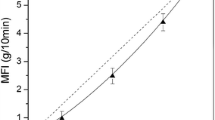Abstract
The viscoelastic behaviour of a number of commercial and newly synthesized linear biodegradable polyesters—poly (ε-caprolactone) (PCLs) with different molecular characteristics was investigated using both rotational and extensional rheometry. The variation of the zero-shear viscosity and relaxation spectrum with molecular weight was studied in detail. The damping function of these PCLs was also determined in order to model their viscoelastic behaviour. The classic Wagner constitutive equation was found to represent the rheology of all PCL polymers quite well. Finally, the PCL processing instabilities were studied by capillary extrusion using a number of capillary dies having various diameter and length-to-diameter ratios. Sharkskin and gross melt fracture was observed at different shear rates depending on the molecular characteristics of the resins and the geometrical details of the capillary dies.






















Similar content being viewed by others
References
Baumgaertel M, Winter HH (1989) Determination of discrete relaxation and retardation time spectra from dynamic mechanical data. Rheol Acta 28:511–519
Baumgaertel M, Schausberger A, Winter HH (1990) The relaxation of polymers with linear flexible chains of uniform length. Rheol Acta 29:400–408
Bird RB, Armstrong RC, Hassager O (1987) Dynamics of polymeric liquids, 2nd edn., vol 1. Wiley, New York
Carreau PJ (1972) Rheological equations from Molecular network theories. Trans Soc Rheol 16:99–127
Dealy JM, Larson RG (2006) Structure and rheology of molten polymers. Hanser, Munich
Dealy JM, Wissbrun KF (1990) Melt rheology and its role in plastics processing—theory and applications. Van Nostrand Reinhold, New York
Ferri J (1980) Viscoelastic properties of polymers. Wiley, New York
Ferri D, Greco F (2006) Nonlinear stress relaxtion of molten polymers: experimental verification of a new theoretical approach. Macromolecules 39:5931–5938
Gimenez J, Cassagnau P, Fulchiron R, Michel A (2000) Structure and dynamics of melt poly(ε-caprolactone) from inverse rheological calculation. Macromol Chem Phys 201:479–490
Grossvenor MP, Staniforth JN (1996) The effect of molecular weight on the rheological and tensile properties of poly(εcaprolactone). Int J Pharm. 135:103–109
Hatzikiriakos SG, Dealy JM (1991) Wall slip of molten high density polyethylene I. sliding plate rheometer studies. J Rheol 35:497–523
Hatzikiriakos SG, Dealy JM (1992a) Wall slip of molten high density polyethylenes II. Capillary rheometer studies. J Rheol 36:703–741
Hatzikiriakos SG, Dealy JM (1992b) Role of slip and fracture in the oscillating flow of HDPE in a capillary. J Rheol 36:845–884
Hatzikiriakos SG, Dealy JM (1994) Start-up pressure transients in a capillary rheometer. Polym Eng Sci 34:493–494
Hutmacher DW (2000) Scafollds in tissue engineering bone and cartilage. Biomaterials 21:2529–2543
Kanev D, Takacs E, Vlachopoulos J (2007) Rheological evaluation and observations of extrusion Instabilities of biodegradable polyesters. Int Polym Process XXII(5):395–401
Kapoor B, Bhattacharya M (1999) Transient shear and extensional properties of biodegradable polycaprolactone. Polym Eng Sci 39:676–687
Kasehagen LJ, Macosko CW (1998) Nonlinear shear and extensional rheology of long chain randomly branched polybutadiene. J Rheol 42:1303–1327
Khatiwala VK, Shekar N, Aggarwal S, Mandal UK (2008) Biodegradation of poly(ε-caprolactone) (PCL) film by Alcaligenes faecalis. J Polym Environ 16:61–67
Kolnaar JWH, Keller A (1997) A singularity in the melt flow of polyethylene with wider implications for polymer melt flow rheology. J Non-Newton Fluid Mech 69:71–98
Mohanty AK, Misra M, Hinrichsen G (2000) Biofibres, biodegradable polymers and biocomposites: an overview. Macromol Mater Eng 276/277:1–24
Nair LS, Laurencin CT (2007) Biodegradable polymers as biomaterials. Prog Polym Sci 32:762–798
Oriani SR, Chapman GR (2003) Fundamentals of melt fracture elimination using fluoropolymer process aid. In: Proceedings of the society of plastic engineers, ANTEC-2003, vol 61, pp 22–26
Othman N, Ramírez JAA, Mehrkhodavandi P, Dorgan JR, Hatzikiriakos SG (2011) Solution and melt viscoelastic properties of controlled microstructure poly(lactide). J Rheol 55:987–1005
Papanastasiou AC, Scriven LE, Macosko CW (1983) Integral constitutive equation for mixed flows: viscoelastic characterization. J Rheol 27:387–410
Pudjijanto S, Denn MM (1994) Astable island in the slip-stick region of linear low-density polyethylene. J Rheol 38:1735–44
Ramamurthy AV (1986) Wall slip in viscous fluids and influence of materials of construction. J Rheol 30:337–358
Ramkumar DHS, Bhattacharya M (1998) Steady shear and dynamic properties of biodegradable polyesters. Polym Eng Sci 38:1426–1435
Ray SS, Bousmina M (2005) Biodegradable polymers and their layered silicate nanocomposites: in greening the 21st century materials world. Prog Mater Sci 50:962–1079
Rolon-Garrido VH, Wagner MH (2009) The damping function in rheology. Rheol Acta 48:245–284
Stanlake LJE, Beard JD, Schafer LL (2008) Rare-earth amidate complexes. Easily accessed initiators for epsilon-caprolactone ring-opening polymerization. Inorg Chem 47:8062–8068
Urakawa O, Takahashi M, Masuda T, Golshan Ebrahimi N (1995) Damping functions and chain relaxation in uniaxial and biaxial enxtensions: comparison with the Doi–Edwards Theory. Macromolecules 28:7196–7201
Wagner MH (1976) Analysis of time-dependent non-linear stress-growth data for shear and elongational flow of a low-density branched polyethylene melt. Rheol Acta 15:136–142
Acknowledgements
Financial assistance from the Natural Sciences and Engineering Research Council (NSERC) of Canada is gratefully acknowledged. Perstorp is also gratefully acknowledged for kindly providing the Capa products for this project.
Author information
Authors and Affiliations
Corresponding author
Rights and permissions
About this article
Cite this article
Noroozi, N., Thomson, J.A., Noroozi, N. et al. Viscoelastic behaviour and flow instabilities of biodegradable poly (ε-caprolactone) polyesters. Rheol Acta 51, 179–192 (2012). https://doi.org/10.1007/s00397-011-0586-6
Received:
Revised:
Accepted:
Published:
Issue Date:
DOI: https://doi.org/10.1007/s00397-011-0586-6



